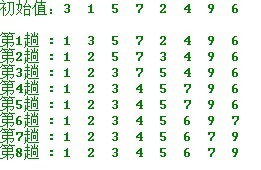基本思想:
在要排序的一组数中,选出最小(或者最大)的一个数与第1个位置的数交换;然后在剩下的数当中再找最小(或者最大)的与第2个位置的数交换,依次类推,直到第n-1个元素(倒数第二个数)和第n个元素(最后一个数)比较为止。
简单选择排序的示例:

操作方法:
第一趟,从n 个记录中找出关键码最小的记录与第一个记录交换;
第二趟,从第二个记录开始的n-1 个记录中再选出关键码最小的记录与第二个记录交换;
以此类推.....
第i 趟,则从第i 个记录开始的n-i+1 个记录中选出关键码最小的记录与第i 个记录交换,
直到整个序列按关键码有序。
算法实现:(杭电ACM 1040) 验证 结果AC啦

#include<iostream> using namespace std; const int N =1005; void sort(int a[],int num); void print(int a[],int num); void swap(int &a,int &b); int main() { int s[N]; int T; cin>>T; while(T--) { int n; cin>>n; for(int j=0;j<n;j++) cin>>s[j]; sort(s,n); print(s,n); cout<<endl; } return 0; } void sort(int a[],int num)//选择排序代码 { for(int i=0;i<num;i++) { int k=i; for(int j=i+1;j<num;j++) { if(a[k]>a[j])//从剩下的元素选择一个最小的元素 k=j; } if(k!=i) { swap(a[k],a[i]);//与最小的元素进行交换 } } } void swap(int &a,int& b)//交换元素 { int temp; temp=a; a=b; b=temp; } void print(int a[],int n)//输出数组元素 { cout<<a[0]; for(int k=1;k<n;k++) { cout<<" "<<a[k]; } }
简单选择排序,每趟循环只能确定一个元素排序后的定位。我们可以考虑改进为每趟循环确定两个元素(当前趟最大和最小记录)的位置,从而减少排序所需的循环次数。改进后对n个数据进行排序,最多只需进行[n/2]趟循环即可。具体实现如下:

#include<iostream> using namespace std; const int N =1005; void SelectSort(int a[],int ); void print(int a[],int num); void swap(int &a,int &b); int main() { int s[N]; int T; cin>>T; while(T--) { int n; cin>>n; for(int j=0;j<n;j++) cin>>s[j]; SelectSort(s,n); print(s,n); cout<<endl; } return 0; } void SelectSort(int arr[],int size) { int minIndex, maxIndex; for (int i = 0; i < size / 2; i++) { minIndex = i; maxIndex = size-i-1; for (int j = i; j < size - i ; j++) { if (arr[j] > arr[maxIndex]) { maxIndex = j; //continue; } if (arr[j] < arr[minIndex]) { minIndex = j; } } if (maxIndex == i && minIndex == size - i - 1) { //特殊交换位置一,当最大的交换位置和最小的交换位置都在最前面和最后面 swap(arr[maxIndex],arr[minIndex]); } else if (maxIndex == i) { //特殊交换位置二,当最大的交换位置是最前面 // Swap(arr[n - i], arr[maxIndex]) swap(arr[size-i-1],arr[maxIndex]); swap(arr[i], arr[minIndex]); } else if (minIndex == size - i - 1) { //特殊交换位置三,当最小的交换位置是最后面 swap(arr[i], arr[minIndex]); swap(arr[size - i-1], arr[maxIndex]); } else { //除了上面三种特殊交换,就剩普通交换了,普通交换随便哪个先交换都行 swap(arr[i], arr[minIndex]); swap(arr[size - i-1], arr[maxIndex]) ; } } } void swap(int &a,int& b)//交换元素 { int temp; temp=a; a=b; b=temp; } void print(int a[],int n)//输出数组元素 { cout<<a[0]; for(int k=1;k<n;k++) { cout<<" "<<a[k]; } }
